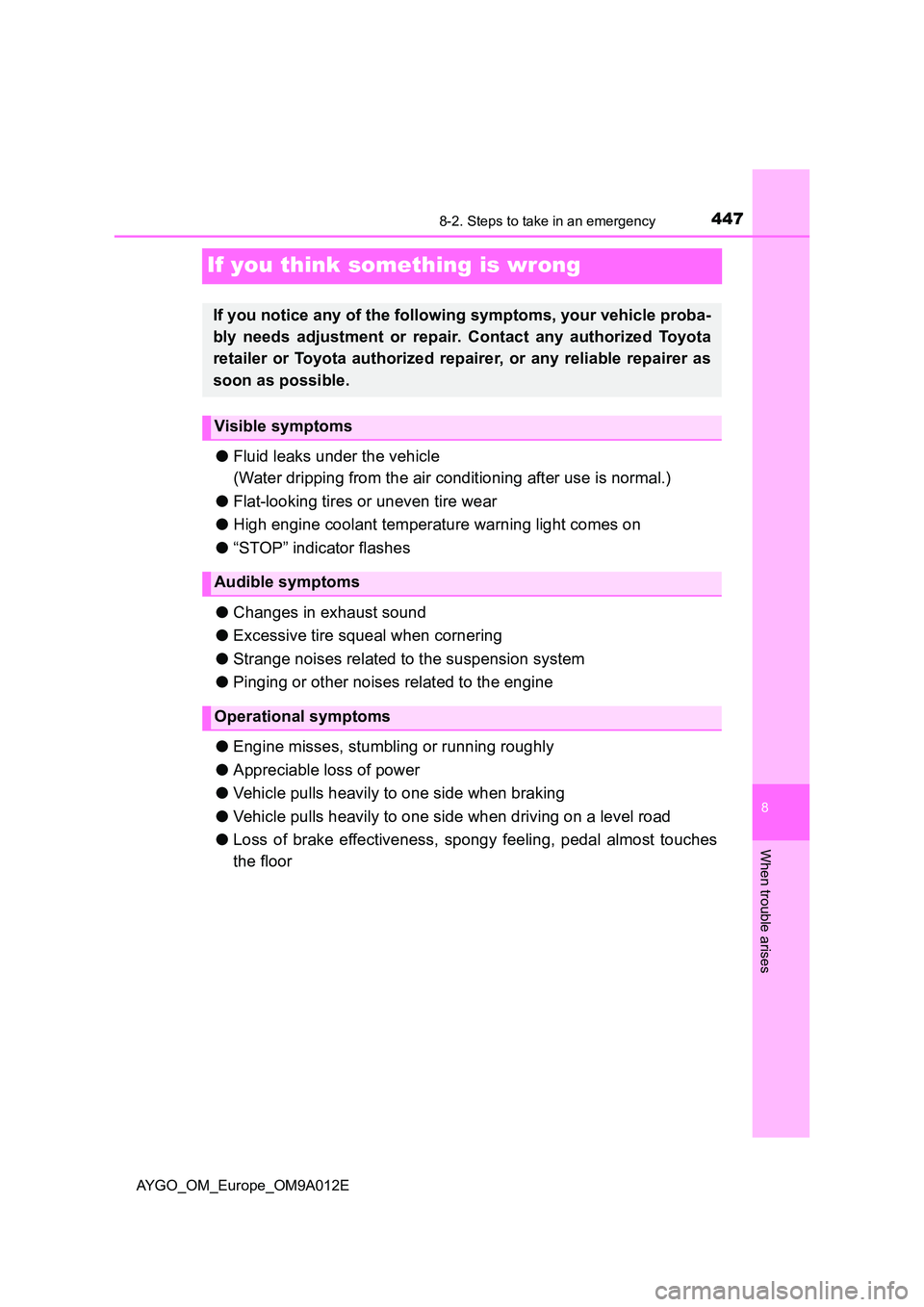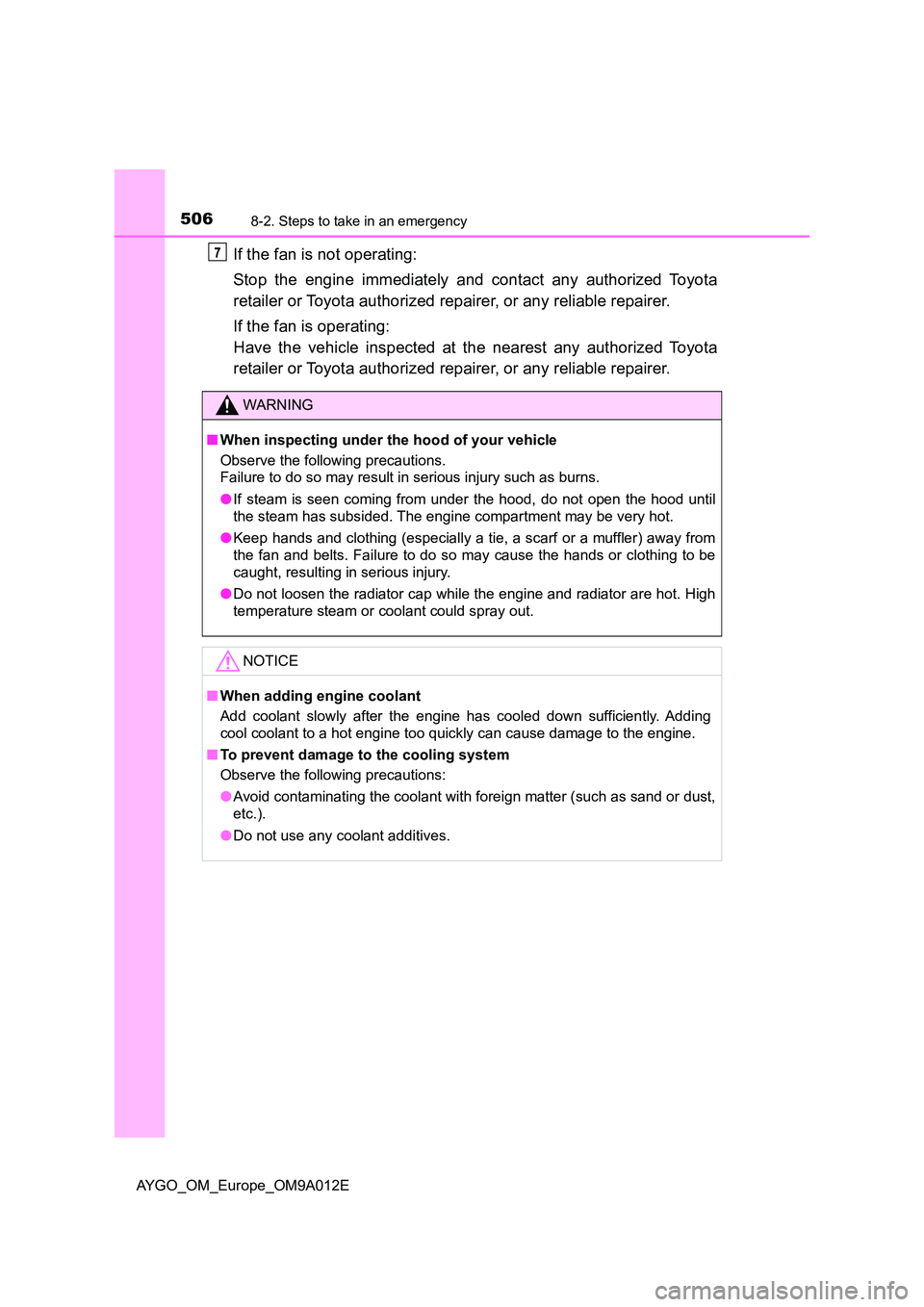Page 395 of 546
3937-3. Do-it-yourself maintenance
7
Maintenance and care
AYGO_OM_Europe_OM9A012E
Engine compartment
Engine oil filler cap
(P. 395)
Fuse box (P. 418)
Battery (P. 399)
Engine coolant reservoir
(P. 397)Radiator (P. 398)
Electric cooling fan
Condenser (P. 398)
Engine oil level dipstick
(P. 394)
Washer fluid tank (P. 402)1
2
3
4
5
6
7
8
9
Page 399 of 546

3977-3. Do-it-yourself maintenance
7
Maintenance and care
AYGO_OM_Europe_OM9A012E
The coolant level is satisfactory if it is between the “FULL” or “F” and
“LOW” lines on the reservoir when the engine is cold.
Ty pe A
Reservoir cap
“FULL” line
“LOW” line
If the level is on or below the
“LOW” line, add coolant up to the
“FULL” line.
Ty pe B
Reservoir cap
“F” line
“LOW” line
If the level is on or below the
“LOW” line, add coolant up to the
“F” line.
■Coolant selection
Only use “Toyota Super Long Life Coolant” or a similar high quality ethylene
glycol based non-silicate, non-amine, non-nitrite, and non-borate coolant with
long-life hybrid organic acid technology.
“Toyota Super Long Life Coolant” is a mixture of 50% coolant and 50%
deionized water. (Minimum temperature: -35C [-31F])
For more details about coolant, contact any authorized Toyota retailer or Toy-
ota authorized repairer, or any reliable repairer.
■If the coolant level drops within a short time of replenishing
Visually check the radiator, hoses, engine coolant reservoir cap, drain cock
and water pump.
If you cannot find a leak, have any authorized Toyota retailer or Toyota autho-
rized repairer, or any reliable repairer, test the cap and check for leaks in the
cooling system.
Engine coolant
1
2
3
1
2
3
Page 400 of 546

3987-3. Do-it-yourself maintenance
AYGO_OM_Europe_OM9A012E
Check the radiator and condenser and clear away any foreign objects.
If either of the above parts is extremely dirty or you are not sure of
their condition, have your vehicle inspected by any authorized Toyota
retailer or Toyota authorized repairer, or any reliable repairer.
WARNING
■ When the engine is hot
Do not remove the radiator cap.
The cooling system may be under pressure and may spray hot coolant if the
cap is removed, causing serious injuries, such as burns.
NOTICE
■ When adding coolant
Coolant is neither plain water nor straight antifreeze. The correct mixture of
water and antifreeze must be used to provide proper lubrication, corrosion
protection and cooling. Be sure to read the antifreeze or coolant label.
■ If you spill coolant
Be sure to wash it off with water to prevent it from damaging parts or paint.
Radiator and condenser
WARNING
■ When the engine is hot
Do not touch the radiator or condenser as they may be hot and cause seri-
ous injuries, such as burns.
Page 449 of 546

4478-2. Steps to take in an emergency
8
When trouble arises
AYGO_OM_Europe_OM9A012E
If you think something is wrong
●Fluid leaks under the vehicle
(Water dripping from the air conditioning after use is normal.)
● Flat-looking tires or uneven tire wear
● High engine coolant temperature warning light comes on
● “STOP” indicator flashes
● Changes in exhaust sound
● Excessive tire squeal when cornering
● Strange noises related to the suspension system
● Pinging or other noises related to the engine
● Engine misses, stumbling or running roughly
● Appreciable loss of power
● Vehicle pulls heavily to one side when braking
● Vehicle pulls heavily to one side when driving on a level road
● Loss of brake effectiveness, spongy feeling, pedal almost touches
the floor
If you notice any of the following symptoms, your vehicle proba-
bly needs adjustment or repair. Contact any authorized Toyota
retailer or Toyota authorized repairer, or any reliable repairer as
soon as possible.
Visible symptoms
Audible symptoms
Operational symptoms
Page 452 of 546

4508-2. Steps to take in an emergency
AYGO_OM_Europe_OM9A012E
(Flashes or comes on)
High engine coolant temperature warning light
Indicates that the engine is overheating.
As the coolant temperature rise, it changes from flashing
to comes on.
P. 504
(Flashes)
“STOP” warning light
Indicates a malfunction in:
• Engine oil pressure is too low; or
• Engine is almost overheating.
Immediately stop the vehicle in a safe place and con-
tact any authorized Toyota retailer or Toyota autho-
rized repairer, or any reliable repairer.
(Comes on)
Multi-mode manual transmissi on warning light (vehicles
with a multi-mode manual transmission)
Indicates a malfunction in the multi-mode manual trans-
mission system.
Have the system checked by any authorized Toyota
retailer or Toyota authorized repairer, or any reliable
repairer.
Multi-mode manual transmission warning light (warning
buzzer) (vehicles with a multi-mode manual transmis-
sion)
Indicates a malfunction in the multi-mode manual trans-
mission system and that the clutch has become hot due to
excessive load.
Pull over and shift the shift lever to N. Wait for about
15 minutes for the clutch to cool down. Have the sys-
tem checked by any authorized Toyota retailer or
Toyota authorized repairer, or any reliable repairer.
(Flashes)
Heat clutch warning light (warning buzzer) (vehicles
with a multi-mode manual transmission)
Indicates that the clutch has become hot, but does not
indicate a malfunction in the multi-mode manual transmis-
sion system.
Pull over and shift the shift lever to N. Wait for about
15 minutes for the clutch to cool down.
Warning lightWarning light/Details/Actions
Page 506 of 546
5048-2. Steps to take in an emergency
AYGO_OM_Europe_OM9A012E
If your vehicle overheats
●The high engine coolant temperature warning light (P. 450) comes
on or flashes, or a loss of engine power is experienced. (For exam-
ple, the vehicle speed does not increase.)
● Steam comes out from under the hood.
Stop the vehicle in a safe place and turn off the air conditioning sys-
tem, and then stop the engine.
If you see steam:
Carefully lift the hood after the steam subsides.
If you do not see steam:
Carefully lift the hood.
After the engine has cooled
down sufficiently, inspect the
hoses and radiator core (radia-
tor) for any leaks.
Radiator
Cooling fan
If a large amount of coolant
leaks, immediately contact any
authorized Toyota retailer or
Toyota authorized repairer, or
any reliable repairer.
The following may indicate that your vehicle is overheating.
Correction procedures
1
2
Page 507 of 546
5058-2. Steps to take in an emergency
8
When trouble arises
AYGO_OM_Europe_OM9A012E
The coolant level is satisfactory if it is between the “FULL” or “F”
and “LOW” lines on the reservoir.
Radiator cap
Reservoir
“FULL” or “F”
“LOW”
Add coolant if necessary.
Water can be used in an emer-
gency if coolant is unavailable.
Start the engine and turn the air conditioning system on to check
that the radiator cooling fan operate and to check for coolant leaks
from the radiator or hoses.
The fan operate when the air conditioning system is turned on immediately
after a cold start. Confirm that the fan is operating by checking the fan
sound and air flow. If it is difficult to check these, turn the air conditioning
system on and off repeatedly. (The fan may not operate in freezing tem-
peratures.)
Ty pe ATy pe B
1
2
3
4
Page 508 of 546

5068-2. Steps to take in an emergency
AYGO_OM_Europe_OM9A012E
If the fan is not operating:
Stop the engine immediately and contact any authorized Toyota
retailer or Toyota authorized repairer, or any reliable repairer.
If the fan is operating:
Have the vehicle inspected at the nearest any authorized Toyota
retailer or Toyota authorized repairer, or any reliable repairer.
WARNING
■ When inspecting under the hood of your vehicle
Observe the following precautions.
Failure to do so may result in serious injury such as burns.
● If steam is seen coming from under the hood, do not open the hood until
the steam has subsided. The engine compartment may be very hot.
● Keep hands and clothing (especially a tie, a scarf or a muffler) away from
the fan and belts. Failure to do so may cause the hands or clothing to be
caught, resulting in serious injury.
● Do not loosen the radiator cap while the engine and radiator are hot. High
temperature steam or coolant could spray out.
NOTICE
■ When adding engine coolant
Add coolant slowly after the engine has cooled down sufficiently. Adding
cool coolant to a hot engine too quickly can cause damage to the engine.
■ To prevent damage to the cooling system
Observe the following precautions:
● Avoid contaminating the coolant with foreign matter (such as sand or dust,
etc.).
● Do not use any coolant additives.